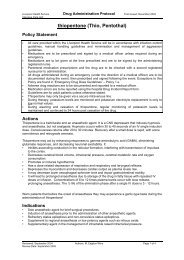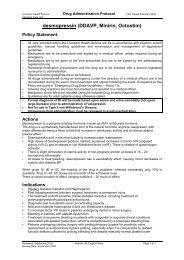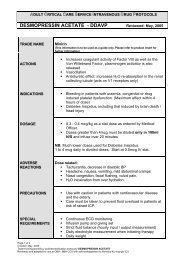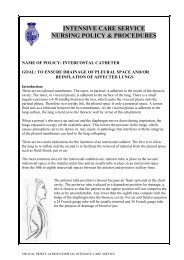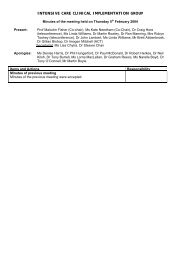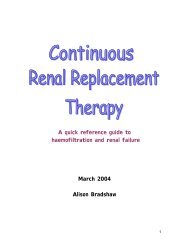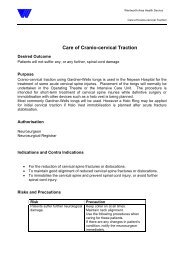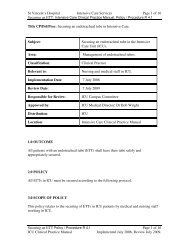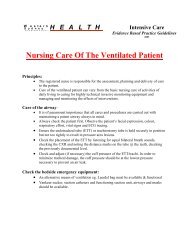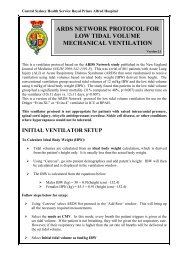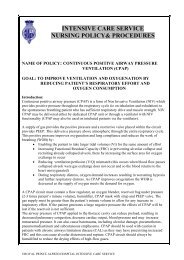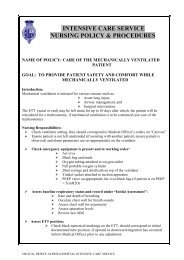Stabilisation of an Endotracheal Tube for the Adult Intensive Care ...
Stabilisation of an Endotracheal Tube for the Adult Intensive Care ...
Stabilisation of an Endotracheal Tube for the Adult Intensive Care ...
Create successful ePaper yourself
Turn your PDF publications into a flip-book with our unique Google optimized e-Paper software.
Number Statement: Choice <strong>of</strong> Method Grade <strong>of</strong><br />
recommendation<br />
2<br />
2a<br />
2b<br />
2c<br />
The methods <strong>for</strong> stabilising <strong>an</strong> ETT c<strong>an</strong> be divided into 3<br />
groups: twill tape; adhesive tape <strong>an</strong>d m<strong>an</strong>ufactured devices.<br />
There is minimal research evidence to support <strong>the</strong> use <strong>of</strong><br />
<strong>an</strong>y one method over <strong>the</strong> o<strong>the</strong>r two. However, <strong>the</strong>re are<br />
principles that c<strong>an</strong> in<strong>for</strong>m <strong>the</strong> choice <strong>of</strong> method <strong>for</strong> specific<br />
clinical situations<br />
The use <strong>of</strong> adhesive tape/devices should be avoided in<br />
patients with impaired facial skin integrity (eg burns,<br />
cellulitis).<br />
The use <strong>of</strong> adhesive tape/devices should be avoided in<br />
patients with extreme diaphoresis.<br />
The use <strong>of</strong> adhesive tape/devices should be avoided in<br />
patients in male patients with beards.<br />
12<br />
Consensus Opinion<br />
Consensus Opinion<br />
Consensus Opinion<br />
Consensus Opinion<br />
There are three main methods <strong>of</strong> achieving tube stabilisation: 1) tying <strong>the</strong> tube to <strong>the</strong><br />
patient’s head using white cotton tape; 2) taping it to <strong>the</strong> patient’s face using medical<br />
adhesive tape; or 3) using a commercial tube holder. Gardner et al (2006) conducted a<br />
systematic review to establish what method <strong>of</strong> ETT stabilisation: 1) resulted in <strong>the</strong> least<br />
amount <strong>of</strong> tube displacement; 2) resulted in <strong>the</strong> least amount <strong>of</strong> unpl<strong>an</strong>ned or accidental<br />
extubations; 3) resulted in <strong>the</strong> least amount <strong>of</strong> facial skin, lip <strong>an</strong>d/or oral mucosa<br />
breakdown; <strong>an</strong>d 4) is preferred by nurses <strong>for</strong> <strong>the</strong> mainten<strong>an</strong>ce <strong>of</strong> oral hygiene. This review<br />
was hampered by <strong>the</strong> heterogeneity <strong>of</strong> design <strong>an</strong>d quality <strong>of</strong> <strong>the</strong> seven studies included. In<br />
addition studies were dated <strong>an</strong>d some <strong>of</strong> <strong>the</strong> commercial products not available in Australia.<br />
No evidence was found regarding outcomes related to tube displacement. One study<br />
(Tominaga, Rudzwick et al. 1995) found that medical adhesive tape signific<strong>an</strong>tly reduced <strong>the</strong><br />
UEX rate over four study periods (15% during control, 4%, 2% <strong>an</strong>d 6% in following<br />
periods). However non-equivalent study periods <strong>an</strong>d treatment <strong>of</strong> patients especially with<br />
respect to sedation <strong>an</strong>d pain relief as well as <strong>the</strong> probability <strong>of</strong> a signific<strong>an</strong>t Hawthorne effect<br />
limit <strong>the</strong> clinical application <strong>of</strong> <strong>the</strong>se findings. By contrast a multicentre prospective<br />
observational study <strong>of</strong> UEX rates in French ICUs identified 46 UEX episodes in 426 patients<br />
over a two-month period (UEX rate = 10.8%). In this study endotracheal fixation with only<br />
thin adhesive tape, orotracheal intubation <strong>an</strong>d <strong>the</strong> lack <strong>of</strong> intravenous sedation were three<br />
factors most common to UEX (Boulain 1998). However <strong>the</strong>re was a limited description <strong>of</strong>




